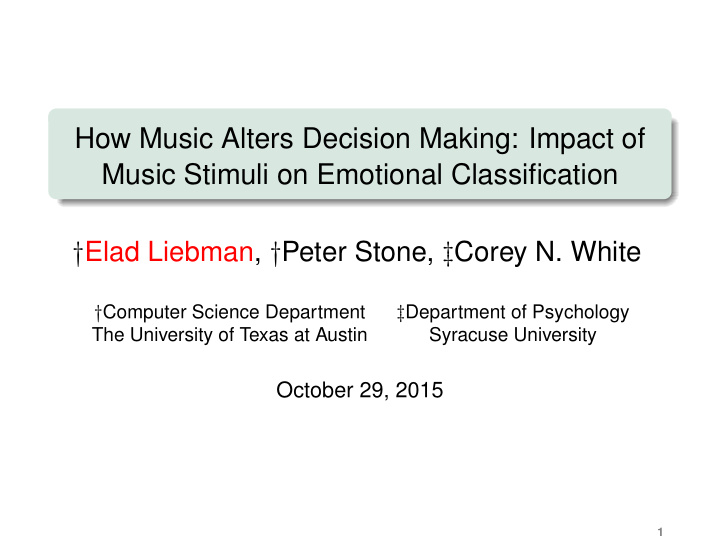



How Music Alters Decision Making: Impact of Music Stimuli on Emotional Classification † Elad Liebman, † Peter Stone, ‡ Corey N. White † Computer Science Department ‡ Department of Psychology The University of Texas at Austin Syracuse University October 29, 2015 1
Overview ◮ Mood can affect emotional processing (Behen 2011, Kuhbandner and Pekrun 2013). ◮ We explored how decision making is affected by music. ◮ Experiment - classify words as positive/negative while listening to music. ◮ Music chosen to induce mood. ◮ Results show music manipulation was effective. 2
Background ◮ Robust evidence of mood-congruent processing, or bias (White et al. 2009, 2010). ◮ Music affects mood, but how does it that effect emotional decision making? 3
Background ◮ People had to perform an emotional task. ◮ ...while listening to music. ◮ To analyze the results, we use a Drift Diffusion Model (DDM)(Ratcliff & McKoon, 2008). ◮ The DDM differentiates two types of bias: ◮ Due to an a priori preference ◮ Due to a shift in how stimuli are evaluated ◮ Model has been used in the past, but not in this context. 4
Methods ◮ Participants were shown words and asked to classify them. ◮ Words taken from a previous paper (White et al. 2013). ◮ Words were categorized into three categories: ◮ Positive - success, happy ◮ Neutral - shelves, sipped ◮ Negative - worried, sad ◮ The task consisted of 4 blocks of 60 trials with 20 stimuli from each word condition. 5
Methods ◮ A different song was played during each block. ◮ Words were randomly assigned (20 of each type). ◮ The DDM was fitted to each participant’s data via convex optimization (minimizing χ 2 ). 6
Methods Experiment console example: 7
Stochastic Modeling 8
Stochastic Modeling 9
Stochastic Modeling 10
Model Fitting Quality 11
Model Fitting Quality 12
Results ◮ Mood-induction successfully affected emotional bias. ◮ Happy music led to more “positive” responses overall. ◮ For the starting point, there was a significant shift. ◮ No reliable effect on the drift rates, response caution or nondecision time. ◮ Music affected the bias, but not the stimulus evaluation. 13
Results 14
Results 15
Results 16
Results 17
Analyzing Individual Auditory Features ◮ The partition to “positive” and “negative” is arbitrary. ◮ How do specific music aspects affect response patterns? ◮ We considered the 8 musical segments used. ◮ We focused on tempo, loudness and major/minor ratio. ◮ Studied how these features correlated with responses. 18
Analyzing Individual Auditory Features 19
Analyzing Individual Auditory Features 20
Analyzing Individual Auditory Features 21
Discussion ◮ Music does not significantly affect content evaluation. ◮ Rather, music initializes a prior preference. ◮ In other words, negative words stay as negative. ◮ But music biases the selection process. ◮ This type of analysis is only possible thanks to the DDM. 22
Discussion ◮ Does this bias originate in the frequent pairing of sad/happy content with sad/happy music, or is it an innate property? Hard to tell. ◮ (...but we can show music correlates with responses on a basic feature level) 23
Summary ◮ Want to understand how music affects processing. ◮ The Drift-Diffusion model decomposed behavior into meaningful constructs. ◮ Participants classified words as positive or negative. ◮ They did so while listening to mood-inducing music. ◮ Music-induced mood affected expectancy. ◮ ...but not stimulus evaluation, caution or encoding time. ◮ Tempo, loudness and harmony are correlated with participant behaviors. 24
Questions? Thank you! 25
Recommend
More recommend